Profiles in Sculpture: Jon Barlow Hudson
Peter J. Marcucci
Special Contributor
Photos Courtesy of Jon Barlow Hudson (Hover over photos for captions)
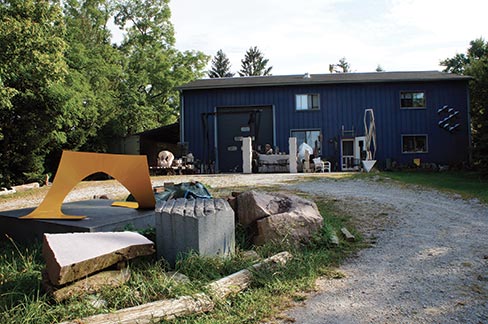 From the time they are born – artists are artists. Their reputations may be self-made through hard work and perseverance, but when they were born, they were born to make art.
From the time they are born – artists are artists. Their reputations may be self-made through hard work and perseverance, but when they were born, they were born to make art.
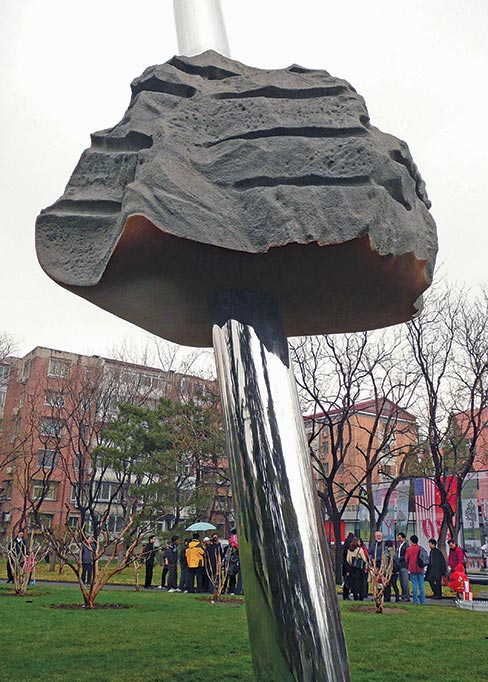 Born in Billings, Montana in 1945, Jon Barlow Hudson was raised till the age of five in Casper, Wyoming by his mother, a teacher, writer and weaver, and father, a groundwater geologist working in the many oil fields in the area. In 1950, great opportunities within the oil biz were knocking at the door, and his father moved to Saudi Arabia to answer those opportunities.
Born in Billings, Montana in 1945, Jon Barlow Hudson was raised till the age of five in Casper, Wyoming by his mother, a teacher, writer and weaver, and father, a groundwater geologist working in the many oil fields in the area. In 1950, great opportunities within the oil biz were knocking at the door, and his father moved to Saudi Arabia to answer those opportunities.
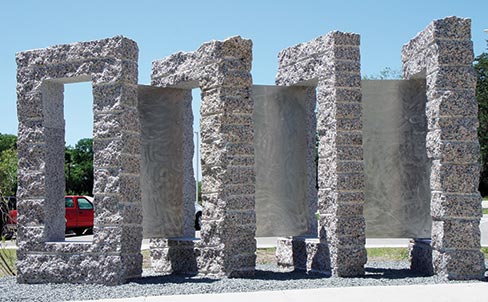 Within a year, Jon, his mom, dad and two brothers had also relocated to Saudi Arabia, staying for three years. Like all kids Jon liked toys, but didn’t at the time have many, so being a resourceful youth, Jon made his own along with the kids’ forts to play in.
Within a year, Jon, his mom, dad and two brothers had also relocated to Saudi Arabia, staying for three years. Like all kids Jon liked toys, but didn’t at the time have many, so being a resourceful youth, Jon made his own along with the kids’ forts to play in.
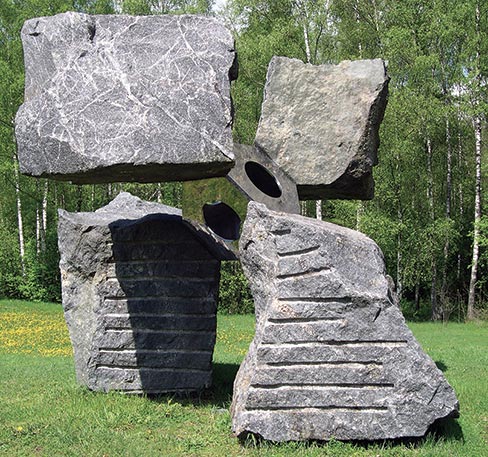 By 1954, the family had returned to America. The post WWII economy was well on its way upward needing oil, machines and electronics, and homes for the many families of the growing “Baby Boom” generation, and unbeknownst to Jon, his new toys were going to be a saw, a drill and a hammer, and a soon to be built two bedroom house would be the fort.
By 1954, the family had returned to America. The post WWII economy was well on its way upward needing oil, machines and electronics, and homes for the many families of the growing “Baby Boom” generation, and unbeknownst to Jon, his new toys were going to be a saw, a drill and a hammer, and a soon to be built two bedroom house would be the fort.
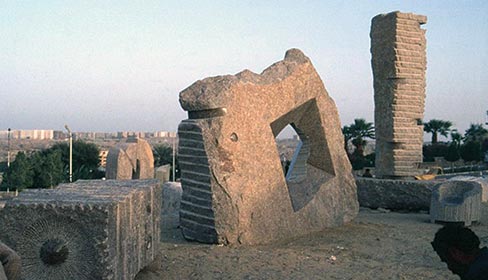 “As a youth, I started making things, and Dad’s groundwater work, many times, would take us to countries like Saudi Arabia, Bolivia and Ecuador for long periods of time, and I didn’t have a lot of toys, so I built my own, and, as a result, became very independent very early as far as making things.
“As a youth, I started making things, and Dad’s groundwater work, many times, would take us to countries like Saudi Arabia, Bolivia and Ecuador for long periods of time, and I didn’t have a lot of toys, so I built my own, and, as a result, became very independent very early as far as making things.
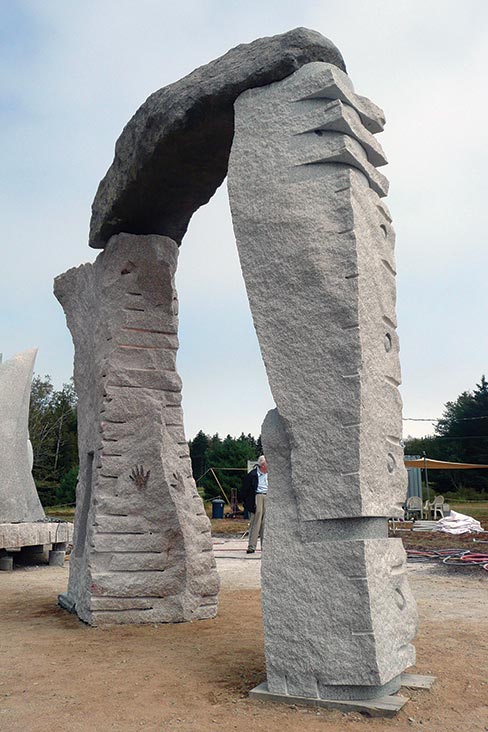 “Then when we came home to the U.S. from a project, Dad had some money and built a house in Yellow Springs, Ohio, and I got to help. I was very fortunate to have built things on a large scale at an early age, and that set me on a track for making things. Of course I was painting and also drew during those years.
“Then when we came home to the U.S. from a project, Dad had some money and built a house in Yellow Springs, Ohio, and I got to help. I was very fortunate to have built things on a large scale at an early age, and that set me on a track for making things. Of course I was painting and also drew during those years.
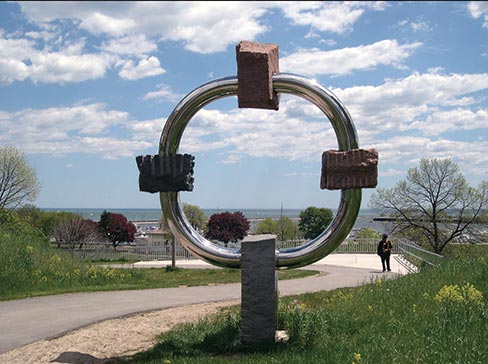 “In high school, I became interested in photography and from that moved to painting during my first years of college at Urbana University in Urbana, Ohio from 1963-65. Learning at that school was minimal, and I think I learned more from fellow students who got me interested in painting and sculpture.
“In high school, I became interested in photography and from that moved to painting during my first years of college at Urbana University in Urbana, Ohio from 1963-65. Learning at that school was minimal, and I think I learned more from fellow students who got me interested in painting and sculpture.
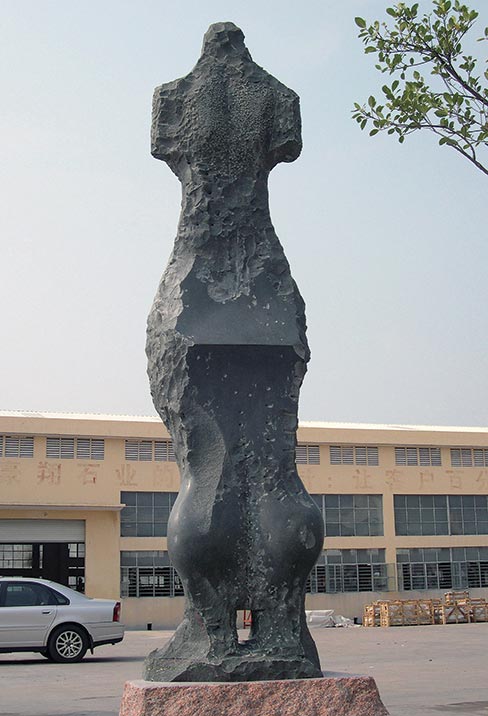 “I then transferred to the Dayton Art Institute (DAI) in 1965, where I learned a lot because they had some really great people there. The students as well as teachers Chuck Ginnever and Bob Koepnick got me interested in building big sculpture in cast bronze, stone and steel.
“I then transferred to the Dayton Art Institute (DAI) in 1965, where I learned a lot because they had some really great people there. The students as well as teachers Chuck Ginnever and Bob Koepnick got me interested in building big sculpture in cast bronze, stone and steel.
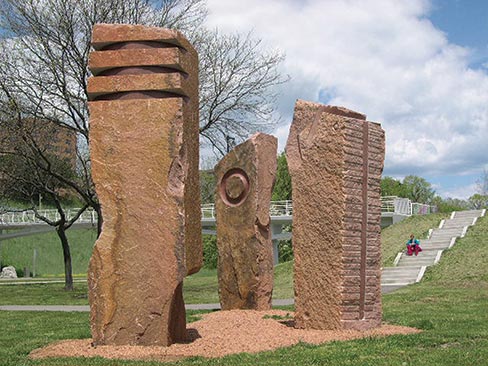 “Then during a summer art program in 1966, I attended the Aspen School of Contemporary Art in Aspen, Colorado, where I found a piece of Yule marble and started messing around with it. That was my first stone sculpture as such.”
“Then during a summer art program in 1966, I attended the Aspen School of Contemporary Art in Aspen, Colorado, where I found a piece of Yule marble and started messing around with it. That was my first stone sculpture as such.”
By 1968, Jon had joined his Dad in Senegal, Australia and began working for Ralph M. Parsons Co., where he ran a water-well cement crew in the bush while also making steel sculpture in the after-hours.
By 1969, having earned enough money to head north through Spain to London, he bought a motorcycle and rode to Stuttgart, Germany to visit a DAI classmate and enrolled at the Stuttgart State Academy of Art and Design to pursue steel sculpture. After a bad motorcycle accident and three weeks in the hospital, it was back to the U.S., where he contacted a good friend.
“When I came back to the U.S., I got hold of Chuck Ginnever, and it turned out I could work for him for a year as an assistant at his farm studio outside of Putney, Vermont. He would often go to New York and have exhibits there. That was a great beginning for me as a professional sculptor.
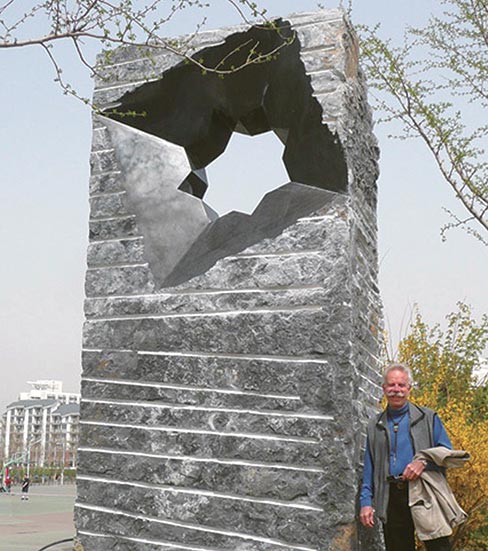 “Then in 1970, Allen Kaprow and Paul Brach from New York, were going to California to start-up California Institute of the Arts, so with Chuck Ginnever’s reference, I got into Cal Arts the first year and got my BFA and stayed the next year and got my Masters.”
“Then in 1970, Allen Kaprow and Paul Brach from New York, were going to California to start-up California Institute of the Arts, so with Chuck Ginnever’s reference, I got into Cal Arts the first year and got my BFA and stayed the next year and got my Masters.”
By 1972, on hiatus from creating art, Jon began working at The Royal Drift Gold Mine in the Sierra Nevada Mountains above Chico, California, making and operating the machinery at the mine. Within a few years Jon realized he needed to get back to art, and in 1974, packed his bags and met up with his parents, now living in Roswell, New Mexico. Soon after that, all of them moved back to Yellow Springs, Ohio where Jon began making stainless steel sculpture as well as teaching sculpture at Wright State University, and later, at Stephens College in Columbia, Missouri.
“After teaching and sculpting metal for several years, I again decided I wanted to broaden my horizons and learn stone and bronze and was awarded a grant from the Institute of International Education which allowed me to go to Carrara, Italy for a year.
“I went to Carrara and got an apartment and worked at the Tomasi Bronze Foundry and the Henraux Sculpture Studio in Pietrasanta. Henraux made rental space available in the middle of their stone factory for artists like myself, and one simply learned by doing and observing the other artists working there.
“When I was there in 1982 and 1983, they had three artists making stone sculptures for Henry Moore, Noguchi, Pomodoro and other notable sculptors. It’s a great area and there is nothing like it anywhere. I’ve been back there a number of times to rent space. That was a life-changing experience and really the beginning of my stone work and what I’ve done ever since.”
So you came back to the states and became a famous artist?
“I’m not so sure I became a famous artist, but I came back and focused on being a sculpting artist. I started going to sculpture symposia around the world and got more experience that way and didn’t start doing big stone commissions till early in the 90s.
“My first public art commission was in 1979 in Miami Dade, Florida, for the Homestead Public Library. One of my earliest big sculptures was in 1994 at a symposium at the Europos Parkas in Vilnius, Lithuania. I think it was the second year for the symposium when the young director had an idea and worked his fanny off and raised the money to build a sculpture park outside of the capitol city of Vilnius.
“Since he was just starting off, he thought he needed to have a big sculpture by an American, and I had the perfect piece, Cloud Hands—it was eleven feet high. I had worked with an American structural engineer to determine the thickness of the stainless steel and size of the anchor bolts needed to keep it together. He told me what to do, and I went to the symposium in Vilnius to build it.”
What was Vilnius like in those days?
“On the edge of Vilnius there is a huge sculpture factory that was built during the Russian occupation, complete with a 30 foot tall bronze statue of Lenin laying out back. It was a fabulous place. The studio building looked like it was big enough to house a dirigible, and they had a giant gantry at the dock for moving humongous stones.
“We had the equipment and the stone there to build the sculpture for the park, and I worked with the artisans to make it. That was my first really big piece. After that, it was many different kinds of stone symposia in different locations around the world.”
I know you were a participant at the 2011 Schoodic International Sculpture Symposium in Maine. Did you enjoy your experience there making public art?
“Oh, it was fabulous. I would go back to Schoodic in a minute. I would have a place there if I had the extra money. I loved the local stone and the people were all wonderful. It was so powerful.”
Why do you make art?
“For me, I think of myself as a sculptor, and my work is about making and communicating and sharing my perceptions about life, spirit, existence, humanity and such. It’s very important for me to make these things. They are tools to communicate with.
“In the past I’ve built machinery and houses, but houses and machinery don’t communicate ideas, experiences, perceptions or spirit, but with sculpture you can. So in that sense, I think of myself as an artist, and I’m trying to communicate something I think of as an extension of human existence, nature and the world, and I’m willing to bust my butt and risk my health to do that because it is so important to me.
“I’ve tried teaching and other things, but nothing else has that value to me like making sculpture does, and even though I sometimes do a public art project or something for a corporation, and those people do have a particular goal or theme in mind, I try to speak to that. I also try to put my own ideas or aesthetics into that work so it’s not just an object for a place—it is a work of art. That is always my hope, and I feel I’ve done a pretty good job of that.”
Before you make one cut or take one chip out of a block, what are you thinking?
“In my early years of working stone, I would often just follow my inspiration, usually in response to the stone as it developed, but now, most often, I have an idea of what the sculpture is intended to be in my mind’s eye, so it is more a matter of like what Michelangelo said, and I remove the excess stone to reveal the image inside.
“With some stones such as the Continuum Uncarved Block series for example, I worked with the given block of stone in its uniqueness and strove to make a sculpture with minimal intervention into the stone. Sentinels, however, was started with a basic vision but then developed as I got to know the three blocks, and I just continued to design in response to their characteristics. Often, when I am given a project to develop a proposal for, I intuitively see the concept in my mind’s eye and then figure out how to make it.”
Do you have a favorite large-scale work you’re especially proud of?
“That is a very hard question because I love all my sculptures. Each place, whether here in the states or overseas, is unique in its own way, as is the place for the sculpture. Cloud Hands of course is very important to me — to be able to make five tons of stone float like one’s hands in the Tai Chi movement.
“For the two sculptures, Compass and Sentinels, produced in Milwaukee in 2005, I was able to work at the ABJ red granite quarry outside Wausau, Milwaukee for the summer. That was a memorable experience. Also attending two symposia at Aswan, Egypt and working with that wonderful ancient stone on a very large scale in that cultural, historical and geographic context was absolutely splendid! Also all the different projects around Asia as well as building my hundred foot high Paradigm for World Expo ’88 in Brisbane, Australia.”
When did you open the shop in Yellow Springs, Ohio?
“My first studio was my Dad’s garage in 1974. I later rented another space downtown for about a year. It was soon after that I decided to commit to building this studio here in Yellow Springs. Over the years, Dad and I had built many houses, and he lent me some money, and he and I got to construct another building together. We actually used a Morton pole barn and designed the building within the engineering parameters of the system.
“Once that was done, Morton came in and put up the building in two weeks. Dad and I then did the interior walls and floors. It’s a very economical way to build and you get a very sturdy building for a very good price per square foot. It’s 36 feet by 60 feet and two stories high, and has a seventeen-foot high shop space with a third of it being office and gallery space in the upstairs. It sits on 1.4 acres on the edge of town. It was great fun to build! That was in 1984.”
Is it difficult for you to get large blocks of stone in and out? What tools and machinery do you use at your shop?
“My shop has a twelve-by-fifteen foot door that allows my gantry crane on wheels to move in and out. It’s rated at two tons and will lift most things that I work on and is very adequate for my needs.
“If I need to move anything heavier than that, I hire a crane. Some sculptors build in big heavy-duty overhead systems, but I figure if I need to move something that big, I’ll just hire someone. Why invest in something that I’m not going to need that often, as so much of my big work I do is distant?”
“My shop is very simple. I just have various hand grinders with various size blades, a Milwaukee core drill, air and hand chisels, polishing pads and some other shop equipment like a table saw, drill press, gas-powered chop-saw and bench grinder. I also have a good stout engine hoist. That’s a tool that every sculptor should have for moving small stones around, and a gantry for bigger things, of course. Really, I can do anything I need to do with just those things.”
Do you do slab work as a sideline when you’re not doing sculpture?
“I don’t do any custom fabrication such as kitchens, although I made countertops for my own home. I’ve been fortunate enough that I can focus on making sculpture and not have to do side jobs. I do stock and use slabs for making sculpture bases, though.”
Do you make any of your own tools, such as chisels?
“No, I don’t get into any of that. Some people are into forging and that kind of stuff, but I don’t have a forge and would rather focus my attention on the work. Everybody has a different approach, but I like to focus on the sculpture. That said, one always comes upon the need for making some kind of tool or adjustment to a tool. That’s fun too, to figure out the challenge of how to build or change something to make it work.”
Do you keep a lot of stone in stock?
“I’ve got too much! I still have the four cutouts of Texas Pink granite from the Fenestrae Aeternitatis sculpture standing outside as well as other cutouts from previous jobs. One attracts stone when you’re a sculptor, so I have lots of it.”
I did see photos of the Fenestrae Aeternitatis sculpture, but I wasn’t sure of where it was placed or what it represented.
“It’s in Dallas at the White Rock Hills Public Library and made of granite quarried in Marble Falls, Texas. A number of years ago I was able to work with some small pieces of Texas Pink Granite and really liked the color and texture, so when the opportunity came up to propose a big piece for a public project, I was eager to propose Texas Pink. They liked that idea, so the four blocks that make up the (four books) are eight and a half feet high by fifty-four inches wide and fourteen inches thick.
“They were huge, so I asked the stone factory to cut the openings in the books using their diamond wire saw. They did that for me and shipped the blocks to a studio I had rented from a local sculptor in Dallas who works in limestone doing figurative work. He’s a great guy and he was happy to rent me space.
“I laid out the blocks and carved the top and the sides to look like the pages of a book. So once I carved the edges and cleaned things up and the foundation was built, I trucked them to the library and bolted on the stainless panels with security bolts, and she was done.”
Do you do your own metal work or use plating?
“Pretty much do my own. Since I’ve done metal for so long it’s fairly easy unless it needs to be bent. Each one of the panels for the Texas sculpture had a 20 degree bend in it, so I had the fab shop do that and also drill the holes and did the installation myself.
“As far as plating, I’ve done it on small pieces, but I don’t do it much anymore. When you use stainless steel as much as I do, you don’t need to plate unless you want some special color or texture. Stainless is so resistant to deterioration and, like stone, it’s a beautiful and tough material that lasts forever. It just depends on the sculpture.”
How often do you use outside sources for cutting, such as diamond wire saws or water-jet?
“Water-jetting is a wonderful technique and any opportunity I can, I’ll use that or diamond wire cutting to get the job done. I’ve used both a number of times in various projects. I do like to do the work myself, but if it’s a job like cutting a giant hole through the stone, it’s far more practical and worth the money to do it right with diamond wire and not drilling through it. I did that with the Aswan sculpture. It is eleven feet high, and the waste that came out of that was used to carve a throne.”
How much of your work is done on speculation, and how do you get your clients?
“I do some pieces for myself, but I tend to focus on commission work. I like the challenge and like when somebody else pays for building it, and I’ve kept busy enough that I haven’t had a lot of time to build for myself. There are a lot of opportunities to exhibit art, but I don’t like doing that because it is so much work for so little return. Your chances of selling are very slim, so I just like focusing on commissioned work. To get most oif my work, I enter competitions around the country, and once in a while someone might contact me. Commissions come to me all ways, but generally I enter public competitions.”
Are you currently working on any large scale or commissioned projects?
“No, I’m not working on a commissioned piece at the moment, though I am a semi-finalist in a public art project here in Ohio. I also just had a call from an architect from New York that I’m waiting to hear back from.
“There is also a three-week symposium in New Zealand soon, so there are things in the works. I’ve really appreciated having some downtime because I’ve needed to finish up a number of things hanging around the studio for years, so I’m happy for that.”
So what does the future hold for you?
“I’m just going to keep trying to get commissions to build big pieces for as long as I can manage it physically. Entering competitions is difficult because you have to spend so much time at the computer with designs and writing to get into them, and if you don’t—you won’t get the job. I don’t have a gallery, so I have to do it. I have slowed down on the symposia though. I guess I’m more interested in doing public work for special places where I know the work will be taken care of in a vital place in the community. So as long as I can do that and a competition here or there, I’m happy.”
Any words of wisdom for the readers?
“If one wants to be an artist, one needs to make lots of art because the more you make, the more experience you have and the more you broaden your creative experience and creative ability. Also try as many different ways of working with stone as you can. It’s also very important to take good care of your health and safety by wearing ear and eye protection and a respirator, because if you don’t have your health, you can’t work. Being health conscience is very important.
“And of course, the spirit in the art and what it is that you want to say to communicate and to share is also important. Working the stone is so much fun. It’s just wonderful material that gives me a joyful satisfaction.”
Peter J. Marcucci has over 25 years of fabrication experience in the stone industry. Send your comments to our Contacts page.